Columbian Mammoth Profile
The woolly mammoth gets all the hype, but it stood at around the same height as an African elephant. While this is larger than anything else living on land today, it was far from the largest mammoth. Its ancestor, on the other hand, the Columbian mammoth, was one of the largest creatures ever to walk on land. So big, you could live in one. And a lot of people did.
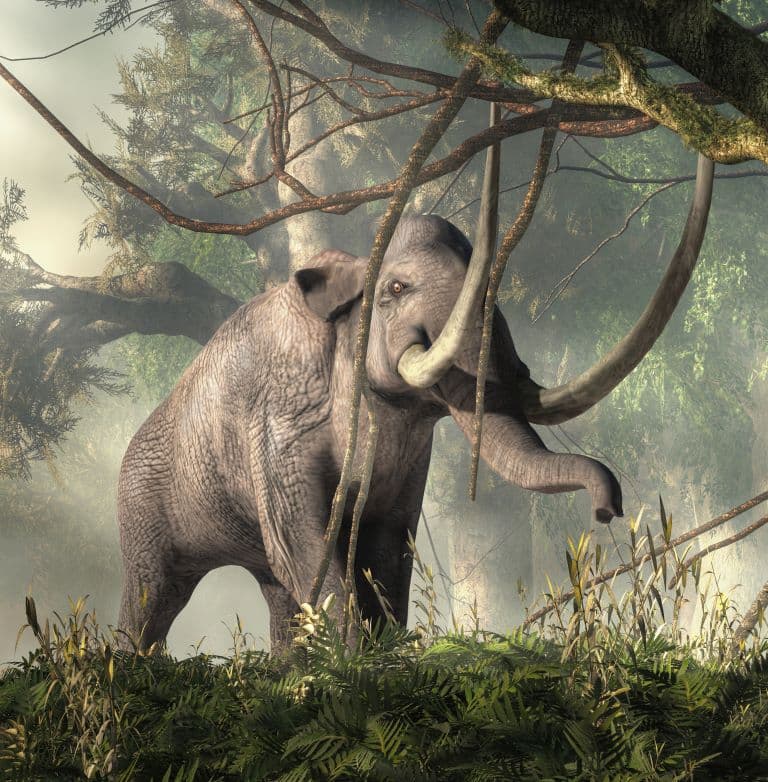
Columbian Mammoth Facts Overview
| Habitat: | Varied: grassland, savanna, wooded regions |
| Location: | North and South America |
| Lifespan: | Possibly over 80 years |
| Size: | 4.2 meters |
| Weight: | 12.5 tons |
| Colour: | Unknown |
| Diet: | Grasses and sedges |
| Predators: | Wolves, big cats, bears, humans |
| Top Speed: | Unknown |
| No. of Species: | 1 |
| Conservation Status: | Extinct |
The Columbian mammoth was one of the largest mammals to ever live on land. With phenomenal tusks and more than 4 meters of height, there wouldn’t have been much that could have brought a mature one down.
These incredible animals provided early American migrants with pretty much all they needed to set up a village, and their remains suggest they played a significant role in these Palaeolithic communities.
Interesting Columbian Mammoth Facts
1. They were once considered burrowing animals
The first half of the word Mammuthus possibly has its roots in the old Russian word for Earth and could relate to the ancient belief that these enormous elephants were burrowing animals, as evidenced by the plethora of bones emerging from the ground.
The second half likely relates to the word behemoth, whose origins probably come from the Hebrew word for beast. So, a mammoth is an Earth beast, or perhaps an Earth horn, on account of it being considered a rooting animal.
Speaking of rooting animals, while the range of the Columbian mammoth did extend all the way down to what is now Colombia, the species name (and, incidentally, the country’s too) comes as a grotesque tribute to the European slaver and genocidaire, Christopher Columbus.
And there’s some irony in that, as the mammoths themselves were much more likely the subject, rather than the perpetrator, of a much earlier and more literal human-led genocide that wiped out the last of the Pleistocene megafauna.
Nowadays, it’s used to describe anything enormous, and this is for good reason since the mammoth was bloody huge.
2. They were one of the largest elephants
Columbian mammoths were one of the greatest in mass and size of any of the elephants. While its ancestors, the Steppe mammoths, were slightly larger, the Columbian mammoth was no slouch.
This gargantuan towered above even the tallest of modern elephants at up to 4.2 meters high and could weigh around 12 tons.
They also had the largest tusks we know of, coming from a specimen sporting almost five meters of ivory on the front of its head. These were much more curved than in extant elephant species and were highly asymmetrical.
Curved tusks like this would have been used for interlocking with a rival, in what must have been one of the most epic battles in the history of land mammals. 1 2
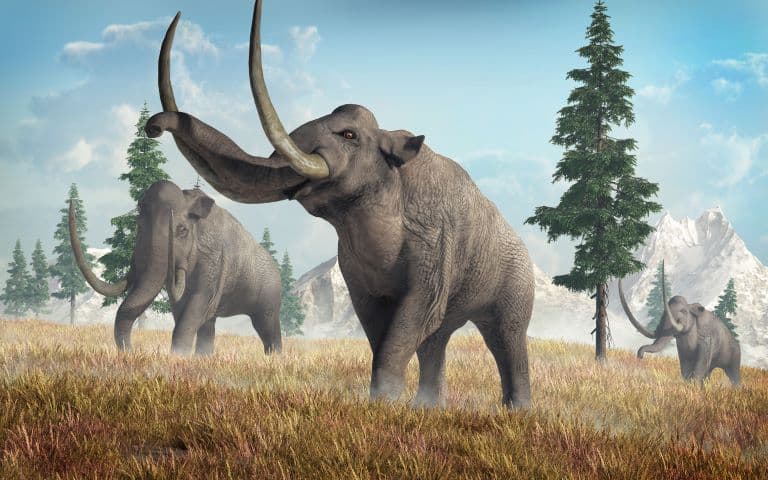
3. But also the smallest
A small subpopulation of these mammoths was discovered on the channel islands, isolated from their Columbian mammoth ancestors for long enough to become a new species entirely.
Over this time – around 30,000 years – they had shrunk to relatively miniature proportions, though they were still about 750kg and two meters at the shoulder. These roughly-horse-sized mammoths
Channel Island mammoths didn’t last much longer than their giant cousins, and by around 10,000 years ago, they too were extinct. 3
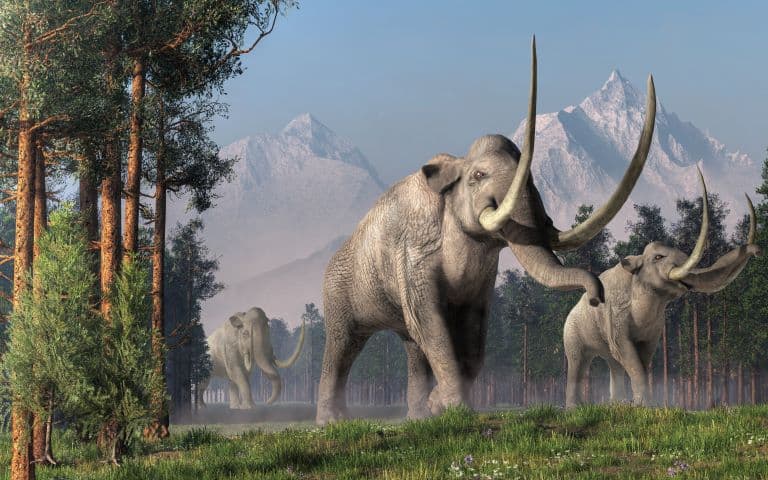
4. They played a huge role in human history
An animal this size provided early human migrants with almost everything they needed. Food is the obvious one, and a 12-ton elephant could have fed entire tribes for weeks if they could have protected the meat from predators.
But more than this, the bones of woolly mammoths have been discovered acting as structural components of the oldest surviving examples of human architecture, so it seems perfectly feasible that the tusks of a Columbian mammoth would once have made for a fantastic gateway into a stone-age compound.
Mammoths would have helped the first settlers compete against some of the most fearsome terrestrial predators to share their space. Tools would have been fashioned out of these bones and tusks, and skins would have provided shelter from the winds and rain, and in at least one instance, an entire village made from mammoth bones has been discovered.
As such, this animal, along with the other mammoth species, would have undoubtedly supported Paleoamericans in countless practical, as well as cultural and spiritual contexts. 4 5
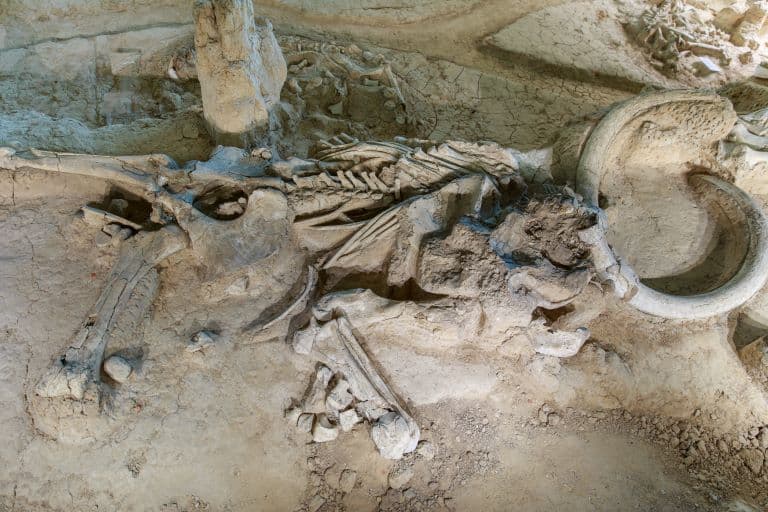
5. They hybridised with woolly mammoths
So much of what we assume about these animals is inferred from an embarrassingly small sample of bones and bone fragments, and so much of the puzzle of their existence is still to be completed.
Recent DNA research has shown some interesting features present in the Woolly mammoth were already in play in the Columbian mammoth too.
Hybridisation between the Columbian mammoth and the lineage that would evolve into the Woolly mammoth appears to have been a common product of their overlapping territories and would have led to speciation events in which the latter evolved to handle far colder climates and migrate into Europe. 6 7
6. They were probably matriarchal
This is something we see in extant elephants and is backed up by the fossil record, which provides numerous extractions of remains containing only young and female specimens.
At least fifteen were found in one site, which must have been a catastrophic event for the herd, and shows us that herds of at least this many would have likely been common, but since mass dyings like this are so rare, it’s impossible to know much more than this about their social structure.
7. They ate a lot
This is hardly surprising, but calculations show that this species would have needed roughly 200kg of food per day, and it would get that from the rough and nutritious grasses and leaves on the plains.
Their teeth were appropriately colossal, and their molars, like those of extant elephants, would be replaced six times throughout their lives, partly to counter the tremendous wear from chewing such abrasive materials for so long, and partly to keep up with their ongoing growth, which likely would have lasted more than 40 years. 8
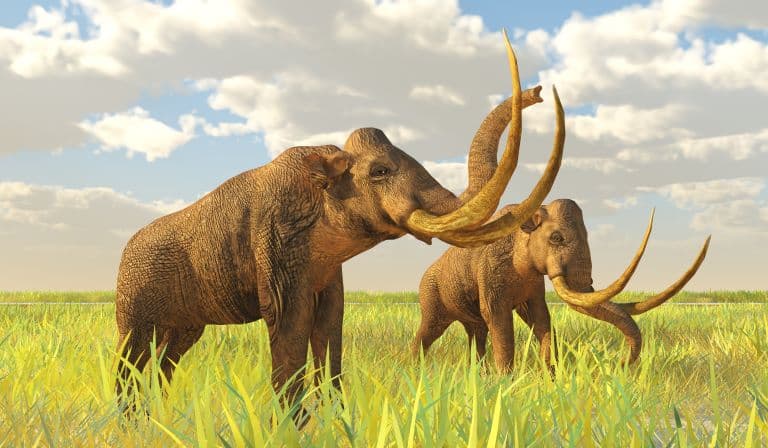
Columbian Mammoth Fact-File Summary
Scientific Classification
| Kingdom: | Animalia |
| Phylum: | Chordata |
| Class: | Mammalia |
| Order: | Proboscidea |
| Family: | Elephantidae |
| Genus: | Mammuthus |
| Species: | columbi |
Fact Sources & References
- “mammoth”, Vocabulary.com.
- Dean R Lomax (2021), “The story of two mammoths, preserved forever in a fight to the death”, BBC Science Focus.
- “The Pygmy Mammoth”, National Park Service.
- Bruce Bower (2022), “Clovis hunters’ reputation as mammoth killers takes a hit”, Science News.
- Author Name (Year), “Article Name”, Publication.
- Tom van der Valk (2021), “Million-year-old DNA sheds light on the genomic history of mammoths”, Nature.
- RILEY BLACK (2012), “Inside the Columbian Mammoth, Signs of a Woolly Cousin”, National Geographic.
- Víctor Adrián Pérez-Crespo (2023), “Feeding habits of Columbian mammoths (Mammuthus columbi) from Santa Lucía IV”, Science Direct.
